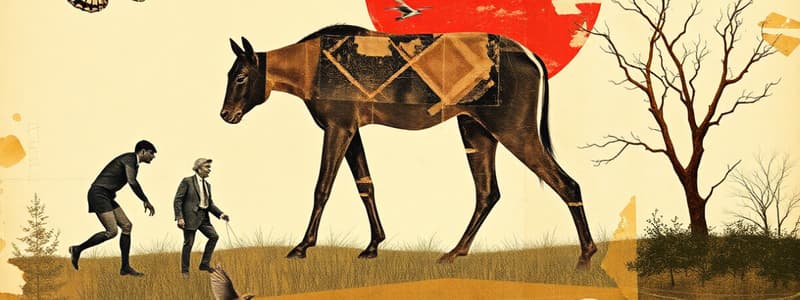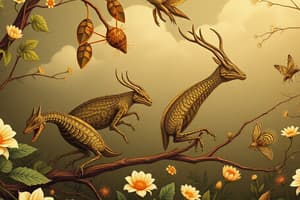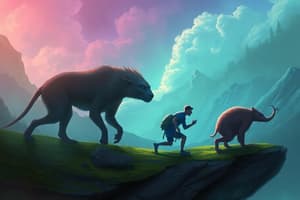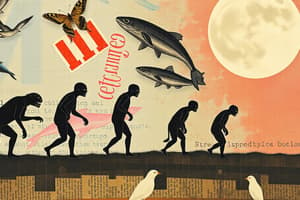Podcast
Questions and Answers
Which type of selection occurs when individuals with intermediate traits are more likely to survive compared to those with extreme traits?
Which type of selection occurs when individuals with intermediate traits are more likely to survive compared to those with extreme traits?
- Directional selection
- Sexual selection
- Stabilizing selection (correct)
- Disruptive selection
Which of the following best describes genetic drift?
Which of the following best describes genetic drift?
- Evolutionary change resulting from interbreeding individuals.
- Change in allele frequency due to natural selection.
- Random changes in allele frequency independent of advantage. (correct)
- The selection of traits that confer a reproductive advantage.
If a population is in Hardy-Weinberg equilibrium, what is true about the allele frequencies over time?
If a population is in Hardy-Weinberg equilibrium, what is true about the allele frequencies over time?
- They fluctuate dramatically.
- They only change due to selection.
- They must equal one.
- They remain the same. (correct)
Which statement accurately describes convergent evolution?
Which statement accurately describes convergent evolution?
In which scenario would disruptive selection likely occur?
In which scenario would disruptive selection likely occur?
What observation led Darwin and Wallace to formulate their theory of natural selection?
What observation led Darwin and Wallace to formulate their theory of natural selection?
Which factor is crucial for natural selection to occur within a population?
Which factor is crucial for natural selection to occur within a population?
What mechanism prevents two species from mating due to differences in mating rituals?
What mechanism prevents two species from mating due to differences in mating rituals?
Which of the following is a postzygotic isolating mechanism?
Which of the following is a postzygotic isolating mechanism?
What is a true statement regarding evolution and natural selection?
What is a true statement regarding evolution and natural selection?
What is the primary reason Huntington's disease persists in the population despite its negative effects?
What is the primary reason Huntington's disease persists in the population despite its negative effects?
Which condition must be met for a population to be in Hardy-Weinberg equilibrium?
Which condition must be met for a population to be in Hardy-Weinberg equilibrium?
When allele frequencies are represented in a Hardy-Weinberg calculation, what do 'p' and 'q' represent?
When allele frequencies are represented in a Hardy-Weinberg calculation, what do 'p' and 'q' represent?
Which scenario disrupts genetic equilibrium in a population?
Which scenario disrupts genetic equilibrium in a population?
Which of the following is NOT a requirement for a population to maintain Hardy-Weinberg equilibrium?
Which of the following is NOT a requirement for a population to maintain Hardy-Weinberg equilibrium?
What describes vestigial structures in the context of evolution?
What describes vestigial structures in the context of evolution?
What is the definition of convergent evolution?
What is the definition of convergent evolution?
Which of the following states the main distinction between homologous and analogous traits?
Which of the following states the main distinction between homologous and analogous traits?
What is an example of divergent evolution?
What is an example of divergent evolution?
Which of the following correctly describes artificial selection?
Which of the following correctly describes artificial selection?
What best exemplifies an analogous structure?
What best exemplifies an analogous structure?
In terms of analogical traits, which statement is true?
In terms of analogical traits, which statement is true?
What is one key observation by Darwin and Wallace regarding species in different regions?
What is one key observation by Darwin and Wallace regarding species in different regions?
Which of the following is NOT characteristic of genetic equilibrium?
Which of the following is NOT characteristic of genetic equilibrium?
Flashcards
Convergent evolution
Convergent evolution
Unrelated species in different environments develop similar traits due to natural selection.
Natural Selection
Natural Selection
Organisms with traits better suited to their environment are more likely to survive and reproduce. Traits are passed to their offspring, leading to evolutionary change.
Phenotypic variation
Phenotypic variation
Differences in observable traits between individuals within a species.
Reproductive success
Reproductive success
Signup and view all the flashcards
Vestigial structure
Vestigial structure
Signup and view all the flashcards
Hardy-Weinberg equilibrium
Hardy-Weinberg equilibrium
Signup and view all the flashcards
Mutation
Mutation
Signup and view all the flashcards
Gene flow
Gene flow
Signup and view all the flashcards
Artificial Selection
Artificial Selection
Signup and view all the flashcards
Fossil Record
Fossil Record
Signup and view all the flashcards
Analogous Traits
Analogous Traits
Signup and view all the flashcards
Homologous Traits
Homologous Traits
Signup and view all the flashcards
Parallel Evolution
Parallel Evolution
Signup and view all the flashcards
Analogous Structures
Analogous Structures
Signup and view all the flashcards
Genetic Drift
Genetic Drift
Signup and view all the flashcards
Allele Frequency
Allele Frequency
Signup and view all the flashcards
Stabilizing Selection
Stabilizing Selection
Signup and view all the flashcards
Disruptive Selection
Disruptive Selection
Signup and view all the flashcards
Directional Selection
Directional Selection
Signup and view all the flashcards
Prezygotic Isolation
Prezygotic Isolation
Signup and view all the flashcards
Study Notes
Artificial Selection
- Process where humans select organisms to live and reproduce based on traits
- Leads to significant changes in observable characteristics (phenotype)
- Fossil record provides evidence of evolutionary changes
Analogous Traits
- Similar morphology in unrelated species
- Result of similar ecological niches, not shared ancestry
- Example: penguin's fin and dolphin's fin (both aquatic)
- Same function, different structures (e.g., bird wing vs. insect wing)
Homologous Traits
- Similar structure in related species
- Evolved from a common ancestor
- Example: human arm and whale's flipper (shared skeletal structure)
- Different functions, similar structure
Convergent Evolution
- Unrelated species evolve similar characteristics in response to similar environments.
- Example: wings in birds, bats, and insects
Divergent Evolution
- Two or more species diverge from a common ancestor
- Example: elephants and mammoths
- Develop unique characteristics despite shared ancestry
Convergent Evolution Example
- Species develop similar traits without sharing common ancestor
- Example: wings in birds, bats, and insects
Natural Selection
- Favors organisms with traits increasing survival and reproduction in a specific environment
- Traits passed to offspring, contributing to evolutionary change
- Environment plays a key role in trait adaptation
Mutation
- Change in DNA
- Can lead to new traits
- A driving force of evolution
Gene Flow
- Movement of genes between populations
- Can lead to similarities in traits
Nonrandom Mating
- Individuals preferentially mate with others sharing similar traits
- Affects allele frequencies
Genetic Drift
- Random changes in allele frequency
- Can be significant in small populations
Selection
- Some alleles are more beneficial than others
- Beneficial traits are more likely to be passed on.
Hardy-Weinberg Equilibrium
- Population's allele and genotype frequencies stay constant without evolution
- Requires specific conditions are met (no mutations, migration, etc.) -Allele frequencies -Gene frequencies
Types of Selection
- Stabilizing Selection - intermediate traits are favored (mice)
- Disruptive Selection - extreme traits are favored (example of mice)
- Directional Selection - one extreme trait is favoured (example of mice)
Prezygotic Isolation
- Prevents zygote formation
- Geographical isolation - Different areas
- Ecological Isolation - Different habitats within the same area.
- Temporal Isolation - Different mating times
- Behavioral Isolation - Different courtship rituals
- Mechanical Isolation - Incompatible reproductive structures.
Postzygotic Isolation
- Problems arise after zygote formation
- Hybrid inviability - Zygote cannot develop
- Hybrid infertility - Zygote can develop but is infertile
Speciation
- Formation of new species.
- Allopatric - Different locations
- Sympatric - Same location
Studying That Suits You
Use AI to generate personalized quizzes and flashcards to suit your learning preferences.




